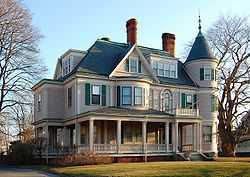Diamond Historic District (Lynn, Massachusetts)
|
Diamond Historic District | |
 | |
|
A large Victorian home in Lynn's Diamond District | |
 | |
| Location | Lynn, Massachusetts |
|---|---|
| Coordinates | 42°27′38″N 70°55′58″W / 42.46056°N 70.93278°WCoordinates: 42°27′38″N 70°55′58″W / 42.46056°N 70.93278°W |
| Built | 1837 |
| Architect | Betts, Thomas; Bixbee, C.A., et al. |
| Architectural style | Federal, Greek Revival, Gothic Revival |
| Governing body | State |
| NRHP Reference # |
96001040 [1] |
| Added to NRHP | October 10, 1996 |
The Diamond Historic District is an expansive 69.5-acre (28.1 ha) residential historic district located between downtown Lynn, Massachusetts and Boston Harbor. Its southern boundary is a concrete seawall running along Lynn Shore Drive between the town lines of Nahant and Swampscott. Its eastern boundary is the town line with Swampscott at Eastern Avenue. The northern boundary runs along Broad and Lewis Streets to Nahant Street, which forms the western boundary. The district is roughly bisected by Ocean Avenue. It includes more than 700 contributing resources, of which almost 500 are single family residences.[2] The district was listed on the National Register of Historic Places in 1996.[1]
The oldest buildings in the district are a few Federal-period buildings in the Washington Square area on Broad Street. This area was settled as early as the 1630s, but the oldest building to survive in the district is the Daniel Newhall House, built c. 1825. Most of the surviving Federal houses are conservative 2.5 story center chimney buildings. There are also relatively few Greek Revival buildings, with a handful of well-preserved specimens surviving.[2]
Development in the area grew more substantially after 1840, and late 19th century architectural styles dominate the district. There are a significant number of Italianate, Queen Anne, and Second Empire houses, most notably the Lucian Newhall Houses, listed on the National Register in 1985. There are fewer Shingle style houses than Queen Anne, both styles that were popular late in the 19th century. The single style best represented in the district is Colonial Revival, with exemplars built between 1890 and 1940. Notable among these is the Charles Lovejoy House, listed separately in 1978.[2]
There are only four religious structures in the district. The oldest, a Quaker meetinghouse, was built c. 1825, while the other three, two churches and a synagogue, all date to the early decades of the 20th century. There are also only a handful of commercial buildings, located on Broad and Lewis Streets, the main traffic artery in the district.[2]
See also
- National Register of Historic Places listings in Lynn, Massachusetts
- National Register of Historic Places listings in Essex County, Massachusetts
References
- ↑ 1.0 1.1 "National Register Information System". National Register of Historic Places. National Park Service. 2008-04-15.
- ↑ 2.0 2.1 2.2 2.3 "NRHP nomination for Diamond Historic District". Commonwealth of Massachusetts. Retrieved 2013-12-22.
| |||||||||||||||||||||||||||||||||||||||||||||||||||||||
